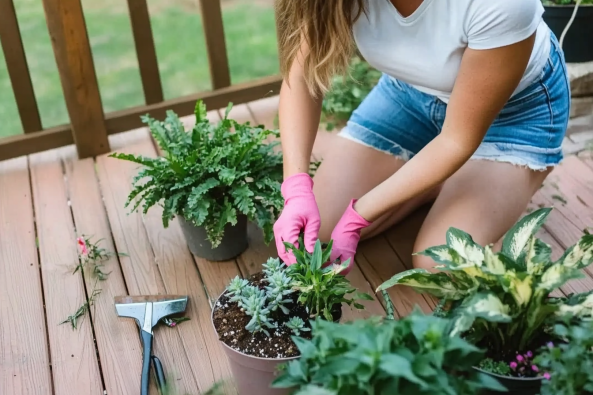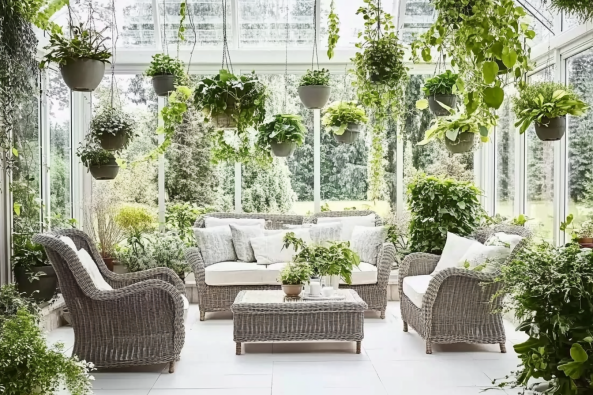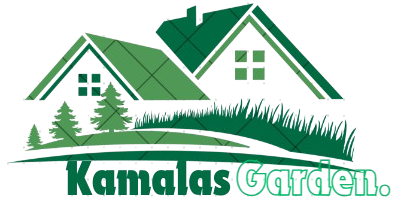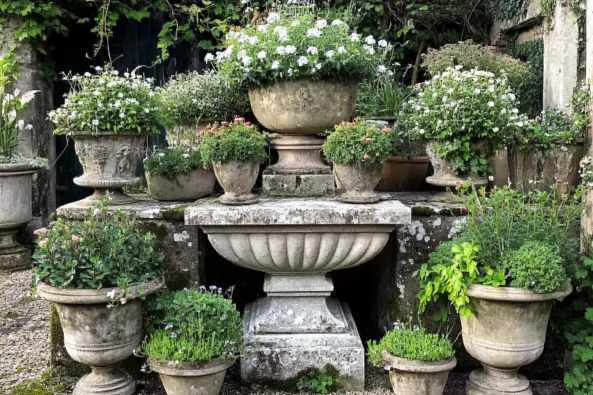Creating a potted garden is a simple and effective way to add life and color to any space, whether you have a small balcony, a patio, or an indoor setting. Container gardening allows for flexibility, creativity, and accessibility, making it a great option for both beginners and experienced gardeners. In this guide, we’ll explore essential tips to ensure your potted garden thrives and elevates your space.
Why Potted Gardens Are Perfect for Any Space
Benefits of Container Gardening
- Easy to manage and maintain
- Perfect for small spaces like balconies and patios
- Provides flexibility to rearrange plants as needed
- Reduces issues with soil-borne pests and diseases
Ideal Spaces for Potted Gardens (Balconies, Patios, Indoors, Small Yards)
- Balconies: Use vertical planters to maximize space.
- Patios: Arrange pots at different heights for visual appeal.
- Indoors: Choose low-light plants to thrive in limited sunlight.
- Small Yards: Create defined areas with container groupings.
Low-Maintenance, High-Impact Gardening
- Select drought-resistant plants for minimal upkeep.
- Use self-watering pots for better moisture control.
- Incorporate slow-release fertilizers to reduce frequent feeding.
Essential Potted Garden Tips for Success

1. Choose the Right Containers for Your Plants
Materials & Durability: Terracotta, Ceramic, Plastic, & Metal
- Terracotta: Breathable but prone to drying out.
- Ceramic: Stylish but heavy and fragile.
- Plastic: Lightweight and retains moisture well.
- Metal: Modern aesthetic but can heat up quickly in direct sun.
Best Container Sizes for Different Plants
- Small pots: Ideal for succulents and herbs.
- Medium pots: Great for annual flowers and perennials.
- Large pots: Suitable for small trees, shrubs, and deep-rooted plants.
Ensuring Proper Drainage to Prevent Root Rot
- Always choose containers with drainage holes.
- Use pebbles or mesh to prevent soil clogging.
- Avoid overwatering by checking soil moisture levels regularly.
2. Use High-Quality Potting Soil for Healthy Growth
Why Regular Garden Soil Won’t Work
- Too dense for proper aeration in containers.
- Retains too much moisture, leading to root rot.
Best Organic Potting Mixes for Containers
- Look for a mix with peat moss, perlite, and compost.
- Avoid synthetic fertilizers for a more natural approach.
Adding Perlite, Compost & Other Soil Boosters
- Perlite improves aeration and drainage.
- Compost enriches soil with essential nutrients.
- Coconut coir retains moisture while allowing good airflow.
3. Selecting the Right Plants for Container Gardening
Best Flowers for Brightening Small Spaces
- Marigolds, petunias, and geraniums provide vibrant color.
- Begonias and impatiens thrive in shady areas.
Low-Maintenance Indoor Plants for Busy People
- Snake plants, pothos, and ZZ plants require minimal care.
- Peace lilies and spider plants improve indoor air quality.
Herbs & Edibles You Can Grow in Pots
- Basil, mint, and rosemary are perfect for kitchen use.
- Tomatoes, peppers, and strawberries thrive in containers.
4. Positioning Your Potted Plants for Optimal Sunlight
How Much Sun Do Different Plants Need?
- Full sun: 6+ hours of direct sunlight.
- Partial sun: 3-6 hours of sunlight.
- Shade-loving: Less than 3 hours of indirect sunlight.
Ideal Locations for Shade-Loving vs. Sun-Loving Plants
- South-facing spots for sun-loving plants.
- North-facing areas for shade-preferring species.
Rotating Plants to Ensure Even Growth
- Turn pots weekly to prevent plants from leaning towards light.
- Adjust placements as the seasons change for maximum exposure.
5. Watering Consistently Without Overwatering
How Often to Water Different Types of Plants
- Daily for small pots in direct sun.
- Every 2-3 days for medium-sized containers.
- Weekly for drought-tolerant plants like succulents.
Best Practices for Watering Potted Plants
- Water early in the morning to prevent evaporation.
- Use a moisture meter to avoid overwatering.
Using Self-Watering Pots & DIY Watering Solutions
- Self-watering pots store excess water for consistent hydration.
- DIY watering solutions like inverted bottles provide slow moisture release.
6. Fertilizing for Lush, Vibrant Growth
Organic vs. Chemical Fertilizers: Which One to Use?
- Organic: Compost tea, fish emulsion, worm castings.
- Chemical: Slow-release pellets for controlled feeding.
How Often to Feed Your Plants
- Every 2-4 weeks during the growing season.
- Reduce feeding in fall and winter.
DIY Natural Fertilizers for Container Gardens
- Banana peels for potassium.
- Eggshells for calcium.
Creative Ideas to Brighten Your Space with Potted Plants

9. Arranging Plants for Maximum Visual Impact
Creating Eye-Catching Color Combinations
- Pair complementary colors like blue and yellow.
- Mix warm tones for an inviting atmosphere.
Mixing Heights & Textures for a Dynamic Display
- Tall plants like ferns for height.
- Low-growers like trailing vines for contrast.
10. Vertical Gardening: Saving Space with Style
Best Vertical Planters for Small Spaces
- Wall-mounted planters, stackable pots, and pallet gardens.
Hanging Baskets, Shelves & Wall-Mounted Planters
- Ideal for balconies and compact patios.
11. Seasonal Container Gardening Ideas
Spring Blooms to Brighten Your Space
- Daffodils, tulips, and hyacinths for fresh spring appeal.
Summer Container Gardens for Outdoor Entertaining
- Vibrant annuals like zinnias and lantanas.
Fall & Winter Potted Plant Ideas
- Chrysanthemums and ornamental kale for autumn.
- Evergreen shrubs and poinsettias for winter decor.
Common Potted Garden Problems & How to Fix Them
13. Preventing & Treating Root Rot
- Signs: Yellowing leaves, mushy roots.
- Fix: Improve drainage, reduce watering frequency.
14. Dealing with Pests in Container Gardens
- Natural solutions: Neem oil, insecticidal soap.
- Companion planting with marigolds deters pests.
15. Keeping Plants Healthy During Extreme Weather
- Use shade cloth in heatwaves.
- Bring sensitive plants indoors during frost.
Final Thoughts: Elevate Your Space with a Beautiful Potted Garden
Choosing the Best Plants for Your Lifestyle
- Consider care levels before selecting plants.
- Opt for easy-to-grow varieties if you’re a beginner.
Maintaining a Low-Maintenance, High-Impact Garden
- Use automation like self-watering systems.
- Choose long-lasting plants that require little upkeep.
Enjoying the Beauty & Benefits of Container Gardening
- A potted garden is an easy way to enhance any space.
- Bring nature indoors while keeping maintenance simple.
Discover more creative garden border ideas and get expert advice from these potted garden tips.

